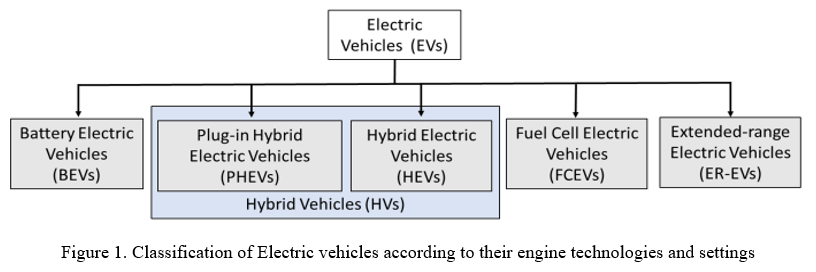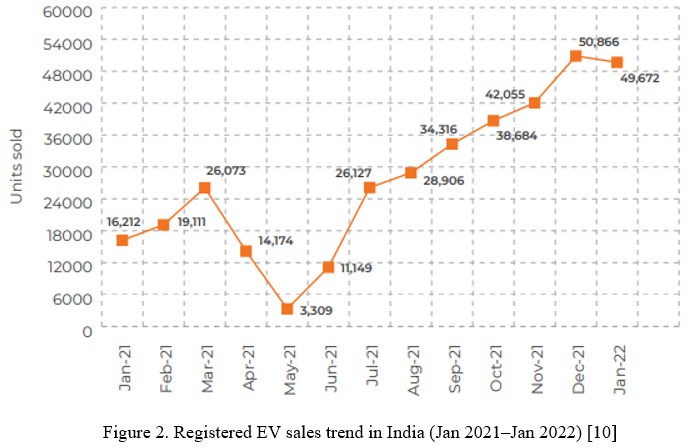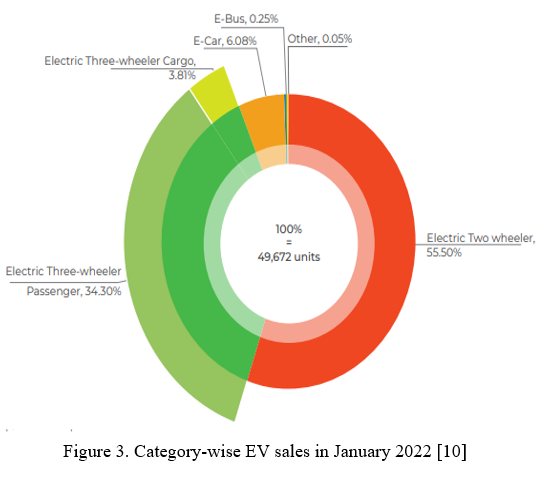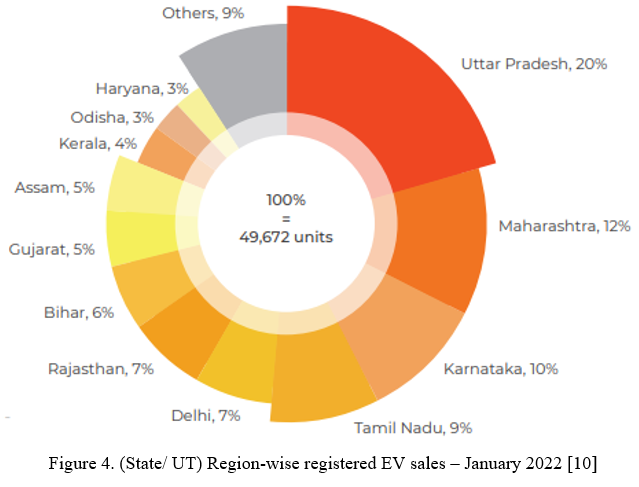Ijraset Journal For Research in Applied Science and Engineering Technology
- Home / Ijraset
- On This Page
- Abstract
- Introduction
- Conclusion
- References
- Copyright
Electric Vehicles in India: Future and Challenges
Authors: Rujuta O. Kambli
DOI Link: https://doi.org/10.22214/ijraset.2022.40297
Certificate: View Certificate
Abstract
For the transportation sector, vehicle electrification is a game changer due to major energy and environmental implications driven by high vehicle efficiency i.e. EVs are approximately 3–4 times more efficient than comparable internal combustion engines vehicles (ICEV), zero tailpipe emissions, and reduced petroleum dependency as great fuel diversity and flexibility exist in electricity production. Far-reaching implications for vehicle grid integration extend to the electricity sector and to the broader energy system. The Indian Government is also planning to increase the electric vehicle in the automobile industries. In this paper the future and challenges of the electric vehicles in Indian market is discussed. The different factors like economic, social, technical and environmental which are affecting the electric vehicles market in India are discussed in this paper. The battery and infrastructure development are related to economic and technological factors. Based on the challenges, recommendations are made and it also helps to promote the market growth of electric vehicles.
Introduction
I. INTRODUCTION
India is the fifth largest car market in the world and has the potential to become one of the top three in the near future with about 40 crore customers in need of mobility solutions by the year 2030.However, as per the Paris agreement, the increasing number of automobile customers shall not imply an increase in the consumption of conventional fuels. To ensure a positive growth rate towards achieving India’s Net Zero Emissions by 2070, a transportation revolution is required in India which will lead to better “walkability”, public transportation; railways, roads and better cars. Solution of “better cars” are likely to be electric.
II. TAXONOMY OF ELECTRIC VEHICLES
In general, EVs they are sorted in five types according to their engine’s technology (Refer Figure 1).

Battery Electric Vehicles (BEVs): vehicles 100% are propelled by electric power. BEVs do not have an internal combustion engine and they do not use any kind of liquid fuel. In order to give the vehicle an acceptable autonomy, BEVs normally use large packs of batteries. A typical BEV will reach from 160 to 250 km, although some of them can travel as far as 500 km with just one charge. An example of this type of vehicle is the Nissan Leaf [1], which is 100% electric and it currently provides a 62 kWh battery that allows users to have an autonomy of 360 km.
Plug In Hybrid Electric Vehicles (PHEVs): hybrid vehicles are propelled by a conventional combustible engine and an electric engine charged by a pluggable external electric source. PHEVs can store enough electricity from the grid to significantly reduce their fuel consumption in regular driving conditions. The Mitsubishi Outlander PHEV [2] provides a 12 kWh battery, which allows it to drive around 50 km just with the electric engine. However, it is also noteworthy that PHEVs fuel consumption is higher than indicated by car manufacturers [3].
Hybrid Electric Vehicles (HEVs): hybrid vehicles are propelled by a combination of a conventional internal combustion engine and an electric engine. The difference with regard to PHEVs is that HEVs cannot be plugged to the grid. In fact, the battery that provides energy to the electric engine is charged thanks to the power generated by the vehicle’s combustion engine. In modern models, the batteries can also be charged thanks to the energy generated during braking, turning the kinetic energy into electric energy. The Toyota Prius, in its hybrid model (4th generation), provided a 1.3 kWh battery that theoretically allowed it an autonomy as far as 25 km in its all-electric mode [4]. Fuel Cell Electric Vehicles (FCEVs): these vehicles are provided with an electric engine that uses a mix of compressed hydrogen and oxygen obtained from the air, having water as the only waste resulting from this process. Although these kinds of vehicles are considered to present “zero emissions”, it is worth highlighting that, although there is green hydrogen, most of the used hydrogen is extracted from natural gas. The Hyundai Nexo FCEV [5] is an example of this type of vehicles, being able to travel 650 km without refuelling.
Extended-range EVs (ER-EVs): these vehicles are very similar to those ones in the BEV category. However, the ER-EVs are also provided with a supplementary combustion engine, which charges the batteries of the vehicle if needed. This type of engine, unlike those provided by PHEVs and HEVs, is only used for charging, so that it is not connected to the wheels of the vehicle. An example of this type of vehicles is the BMW i3 [6], which has a 42.2 kWh battery that results in a 260 km autonomy in electric mode, and users can benefit an additional 130 km from the extended range mode.
III. MARKET OVERVIEW
The market of EV is growing more after the implementation of FAME (Faster Adoption and Manufacture of Hybrid and Electric Vehicles) scheme in 2015 by Ministry of Heavy Industry and Public Enterprises. The India electric vehicle market was valued at USD 5.47 Billion in 2020, and it is expected to reach USD 17.01 Billion by 2026, growing at a CAGR of 23.47% over the forecast period (2021-2026) [7]. The government of India has undertaken multiple initiatives to promote the manufacturing and adoption of electric vehicles in India, to reduce emissions pertaining to international conventions, and to develop e-mobility in the wake of rapid urbanization [7].
- The Indian government has provided tax exemptions and subsidies to the EV manufacturers and consumers to promote the domestic electric vehicle industry
- The Ministry of Power issued a clarification stating that no license is required to operate EV charging stations in India. The reason behind for making it license-free is that the government considers EV charging station as a service and not the sale of electricity.
- The Ministry of Road Transport and Highways also announced that all battery-operated, ethanol-powered, and methanol-powered transport vehicles would be exempted from the requirement of permits.
- The government has imposed 15% customs duty on parts that are used to manufacture electric vehicles and 10% on imported lithium-ion cells as per the phased manufacturing proposal.
The Indian Electric Vehicle Market is classified as Vehicle Type and Power Source. By Vehicle Type, the market is classified into Passenger Cars, Commercial Vehicles, Two-Wheelers, and Three-wheelers. By Power Source Type, the market is classified into Battery Electric Vehicle, Plug-in Electric Vehicle, and Hybrid Electric Vehicle.
IV. ELECTRIC VEHICLES AND INDIA
- Origin and Increasing Scope: The push for Electric Vehicles (EVs) is driven by the global climate agenda established under the Paris Agreement to reduce carbon emissions in order to limit global warming. The global electric mobility revolution is today defined by the rapid growth in electric vehicle (EV) uptake. About two in every hundred cars sold today are powered by electricity with EV sales for the year 2020 reaching 2.1 million [8]. The global EV fleet totalled 8.0 million in 2020 with EVs accounting for 1% of the global vehicle stock and 2.6% of global car sales [8]. Falling battery costs and rising performance efficiencies are also fuelling the demand for EVs globally.
- Need for Electric Vehicles: India is in need of a transportation revolution. The current trajectory of adding ever more cars running on expensive imported fuel and cluttering up already overcrowded cities suffering from infrastructure bottlenecks and intense air pollution is unfeasible. The transition to electric mobility is a promising global strategy for decarbonising the transport sector.
- India’s Support to EVs: India is among a handful of countries that support the global EV30@30 campaign, which aims for at least 30% new vehicle sales to be electric by 2030. Various ideas were espoused by India at the Glasgow summit, such as, renewable energy catering to 50% of India’s energy needs, reducing carbon emission by 1 billion tonnes by 2030 and achieving net zero by 2070 [8].
The government of India has taken various measures to develop and promote the EV ecosystem in the country such as:
- The remodelled Faster Adoption and Manufacturing of Electric Vehicles (FAME II) scheme
- Production Linked Incentive (PLI) scheme for Advanced Chemistry Cell (ACC) for the supplier side
- The recently launched PLI scheme for Auto and Automotive Components for manufacturers of electric vehicles.
4. EV Sales Trends
The overall EV sales in January 2022 clocked 49,672 units [9].

As depicted in the figure (3) below, EV registrations in January 2022 were driven by electric two-wheelers and passenger-type electric three-wheelers, which together accounted for 89.8% of total registrations in the month. The shares of these categories were followed by e-cars (6.1%) cargo-type electric three-wheelers (3.8%), and so on [10].

Among all the states and UTs, Uttar Pradesh continued to have maximum monthly registered EV sales with a 20% share in overall sales in India in January 2022. Maharashtra had the 2nd highest sales at 12% share, followed by Karnataka (10%), Tamil Nadu (9%), Delhi (7%), and Rajasthan (7%) [9].

V. CHALLENGES ASSOCIATED WITH EV
- Battery Manufacturing: It is estimated that by 2020-30 India’s cumulative demand for batteries would be approximately 900-1100 GWh. However, there is concern over the absence of a manufacturing base for batteries in India, leading to sole reliance on imports to meet rising demand. As per government data, India imported more than $1 billion worth of lithium-ion cells in 2021, even though there is negligible penetration of electric vehicles and battery storage in the power sector.
- Consumer Related Issues: In 2018, India was reported to have only 650 charging stations, which is quite less than the neighbouring counterparts who already had over 5 million charging stations.
a. Lack of charging stations makes it unsuitable for the consumers in covering long range.
b. Moreover, it takes up to 12 hours for a full charge of a vehicle at the owner’s home using a private light-duty slow charger.
c. Also, the cost of a basic electric car is much higher than the average price of a car running on conventional fuel.
3. Policy Challenges: EV production is a capital-intensive sector requiring long term planning to break even and profit realization, uncertainty in government policies related to EV production discourages investment in the industry.
4. Lack of Technology and Skilled Labour: India is technologically deficient in the production of electronics that form the backbone of the EV industry, such as batteries, semiconductors, controllers, etc. EVs have higher servicing costs which require higher levels of skills. India lacks dedicated training courses for such skill development.
5. Unavailability of Materials for Domestic Production: Battery is the single most important component of EVs. India does not have any known reserves of lithium and cobalt which are required for battery production. Dependence on other countries for the import of lithium-ion batteries is an obstacle in becoming completely self-reliant in the battery manufacturing sector.
VI. OPPORTUNITIES IN EV
- Electric Vehicle as Way Forward: EVs will contribute to improving the overall energy security situation as the country imports over 80% of its overall crude oil requirements, amounting to approximately $100 billion. The push for EVs is also expected to play an important role in the local EV manufacturing industry for job creation. Additionally, through several grid support services, EVs are expected to strengthen the grid and help accommodate higher renewable energy penetration while maintaining secure and stable grid operation.
- Opportunities for Battery Manufacturing and Storage: With recent technology disruptions, battery storage has great opportunity in promoting sustainable development in the country, considering government initiatives to promote e-mobility and renewable power (450 GW energy capacity target by 2030 [11]).With rising levels of per capita income, there has been a tremendous demand for consumer electronics in the areas of mobile phones, UPS, laptops, power banks etc. that require advanced chemistry batteries. This makes manufacturing of advanced batteries one of the largest economic opportunities of the 21st century.
- EV Charging Infrastructure: An EV charging infrastructure that draws power from local electricity supply can be set up at private residences, public utilities such as petrol and CNG pumps, and in the parking facilities of commercial establishments like malls, railway stations, and bus depots. The Ministry of Power has prescribed at least one charging station to be present in a grid of 3 km and at every 25 kms on both sides of the highways. The Ministry of Housing and Urban Affairs under the Model Building Bye-laws, 2016 (MBBL) has mandated setting aside 20% of the parking space for EV charging facilities in residential and commercial buildings [12]. Giving effect to the MBBL will also require the state governments to introduce necessary amendments to their respective building bye-laws [12].
- Increasing R&D in EVs: The Indian market needs encouragement for indigenous technologies that are suited for India from both strategic and economic standpoint. Since investment in local research and development is necessary to bring prices down, it makes sense to leverage local universities and existing industrial hubs. India should work with countries like the UK and synergise EV development.
Conclusion
EVs hold great promise to replace ICEVs for a number of on-road applications. EVs can provide a number of benefits, including addressing reliance on petroleum, improving local air quality, reducing GHG emissions, and improving driving experience. Vehicle electrification aligns with broader electrification and decarbonization trends and integrates synergistically with mobility changes, including urban micro-mobility, automation, and mobility-as-a-service solutions. The effective integration of EVs into power systems presents numerous opportunities for synergistic improvement of the efficiency and economics of electromobility and electric power systems, with EVs capable of supporting power-system planning and operations in several ways.
References
[1] insideEVs. Nissan Reveals LEAF e-Plus: 62 kWh Battery, 226-Mile Range. 2019. Available online: https://insideevs.com/nissan -reveals-leaf-e-plus-ces/ (accessed on 17 February 2021). [2] Mitsubishi Motors. Mitsubishi Outlander PHEV 2018. 2019. Available online: https://www.mitsubishicars.com/outlander-phe v/2018/specifications (accessed on 17 February 2021). [3] Plötz, P.; Moll, C.; Bieker, G.; Mock, P.; Li, Y. Real-World Usage of Plug-In Hybrid Electric Vehicles: Fuel Consumption, Electric Driving, and CO2 Emissions; Technical Report; International Council on Clean Transportation Europe (ICCT): Washington, DC, USA, 2020. Available online: https://theicct.org/sites/default/files/publications/PHEV-white20paper-sept2020-0.pdf (accessed on 22 February 2021). [4] The Car Guide. 2014 Toyota Prius PHV: To Plug in or Not to Plug in? 2014. Available online: https://www.guideautoweb.com/e n/articles/21152/2014-toyota-prius-phv-to-plug-in-or-not-to-plug-in/ (accessed on 21 February 2021). [5] Hyundai. All-New Hyundai NEXO—Technical Specifications. 2019. https://www.hyundai.news/eu/press-kits/all-new-hyundai-nexo-technical-specifications/ (accessed on 21 February 2021). [6] insideEVs. 2019 BMW i3, i3 REx, i3s & i3s REx: Full Specs. 2019. Available online: https://insideevs.com/2019-bmw-i3-rex-i3srex-full-spec/ (accessed on 21 February 2021). [7] Report on India Electric Vehicle (EV) Market - Growth, Trends, Covid-19 Impact, and Forecasts (2022 - 2027). [8] Report on Electric Vehicles - India\'s Future - Drishti IAS. [9] Monthly EV update - January 2022 - JMK Research & Analytics. [10] Vahan Dashboard, JMK Research. [11] https://mnre.gov.in/ [12] https://pib.gov.in/Pressreleaseshare.aspx?PRID=1564744#:~:text=The%20Ministry%20of%20Housing%20and,order%20to%20facilitate%20availability%20of
Copyright
Copyright © 2022 Rujuta O. Kambli. This is an open access article distributed under the Creative Commons Attribution License, which permits unrestricted use, distribution, and reproduction in any medium, provided the original work is properly cited.

Download Paper
Paper Id : IJRASET40297
Publish Date : 2022-02-10
ISSN : 2321-9653
Publisher Name : IJRASET
DOI Link : Click Here
 Submit Paper Online
Submit Paper Online

